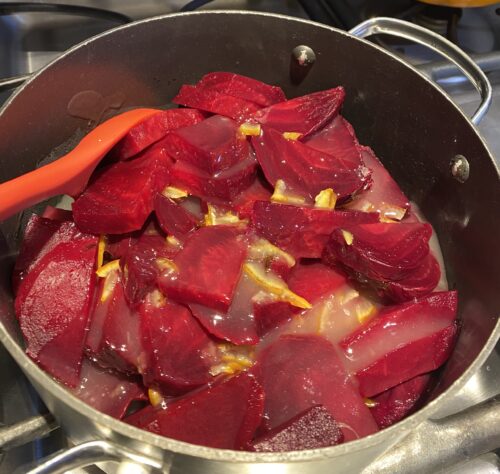
Harvard Beets

I love Harvard beets!
As a child I was only exposed to pickled beets and although my grandmother's were good I just never would have requested them as a side dish. The sorry canned ones served in salad bars across the country have pretty much formed many Americans' lukewarm attitudes toward them. So you can imagine my surprise when I discovered Harvard beets.
These little dark red love bombs moved me to eat them while the product shoot was in process, they are so good. The soft/crunchy beet texture is still there, but now it is couched in a sweet/sour sauce that oozes around each slice of beet and just makes you smack your lips and want more. There's butter, sugar, vinegar (or wine) and a few cloves to add even more interest. I like the additional orange marmalade (talk about sweet/tart in its own right!) to brighten up the overall flavors from a different angle.
Harvard beets are really easy. The most time consuming part is boiling the beets until done. I will warn you, they take longer to cook than potatoes - probably because of their density. You can also use canned beets in a pinch, but cooking the beets fresh is best.
As you are preparing the sauce, you'll notice that it is pale and translucent when it is done. Rest assured that the beets will color the sauce as soon as you stir it in. Beets were used for red dye, and still can be used to dye eggs and fabrics. Which reminds me, don't wear your nice clothes when making beet dishes unless you have an apron that covers well.
I have seen a few theories for why this dish is called Harvard Beets. One is that it is such a deeply red dish that it is reminiscent of the dark crimson of Harvard University's school colors. Given that it appears to have originated in the Boston area, this makes sense.
According to New England Today: "Harvard Beets are from Harvard, MA! This could actually be true, as Fanny Farmer had a summer residence here – and probably grew beets in the rocky – but fertile – soil! (reference: above notation on the origin of beet recipe in Fanny Farmer cookbook.)"
Another theory is that it originated at a restaurant/pub in England called Harwood. It crossed the ocean, met a number of accents and ended up Harvard.
Whichever way it got here, this is a capital way of cooking and presenting beets.
Ingredients
- 2 lb Beets (fresh)
- 1/2 cup Sugar
- 2 tbsp Cornstarch
- 1/2 tsp Salt
- 6 Cloves (whole)
- 1 oz Butter
- 2 tbsp Orange marmalade
- 1/2 cup Apple Cider Vinegar (or a dry white wine)
Instructions
- 1 In a large pot, cover beets with water and boil until fork tender; the tines of the fork should easily pierce the beet.
- 2
Drain the beets and cool to warm. You should be able to peel them with your fingers or use a vegetable peeler.- 3
 In a separate small saucepan, thoroughly combine the sugar, cornstarch, salt and cloves
In a separate small saucepan, thoroughly combine the sugar, cornstarch, salt and cloves- 4
 Add the vinegar and cook over medium heat until translucent and the consistency of a thick pudding.
Add the vinegar and cook over medium heat until translucent and the consistency of a thick pudding.- 5
Remove from heat and stir in the butter and orange marmalade.- 6
 Pour mixture over beets and stir to combine.
Pour mixture over beets and stir to combine.
- 7
 Reheat at medium low.
Serve immediately.
Reheat at medium low.
Serve immediately.COPYRIGHT © 2021 Harriett's Cooking
- 2